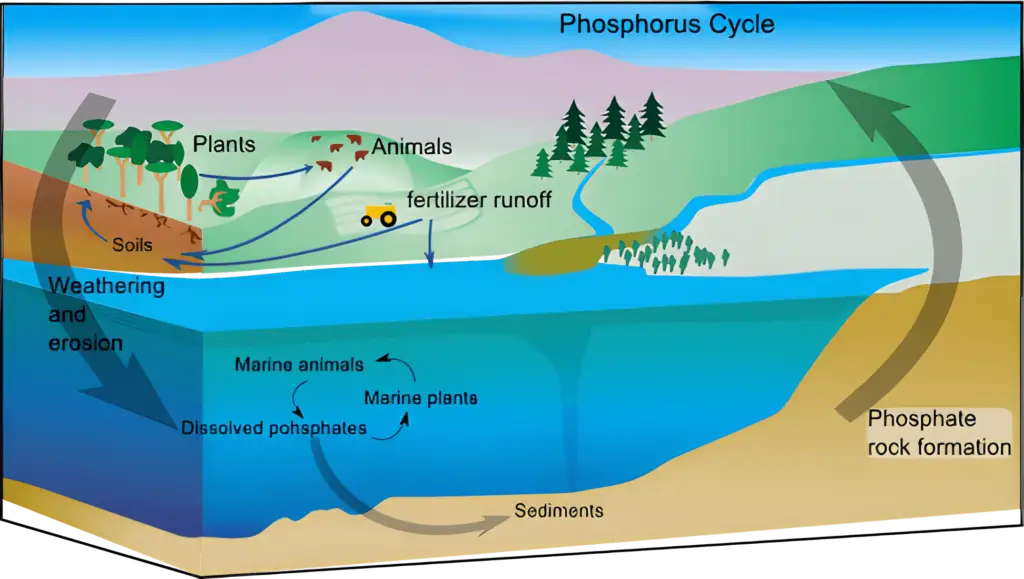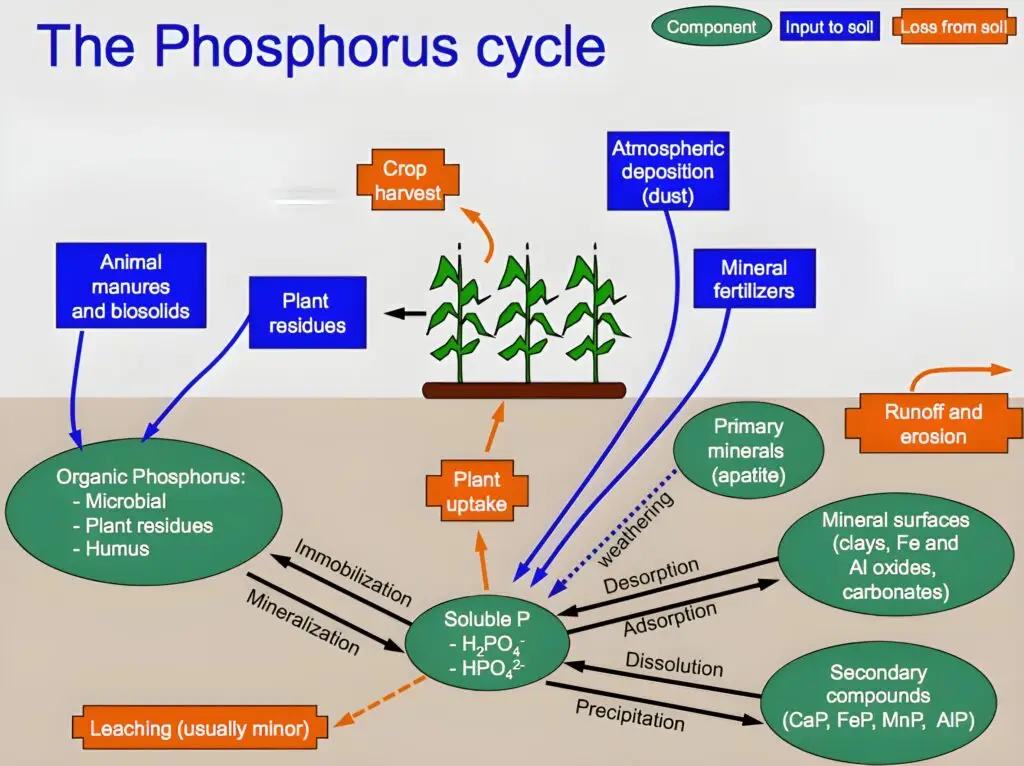The phosphorus cycle is the biogeochemical cycle that describes the movement of phosphorus through the lithosphere, hydrosphere, and biosphere.
Phosphates are essential for growing and maintaining animal and human bones and teeth. In contrast, organic phosphates are required for cell division involving the production of nuclear DNA (deoxyribonucleic acid) and RNA (ribonucleic acid).
Phosphorus is not found in the atmosphere. The plants obtain the phosphorus from the soil as dihydrogen phosphate (H2PO3) or hydrogen phosphate (H2PO4).
Inside the plant body, it does not undergo reduction; instead remains as phosphate as a constituent of Nucleic acid, phosphorylated carbohydrates, and fats.

Steps of the Phosphorus Cycle
- Weathering
- Absorption by Plants
- Absorption by Animals
- Return of phosphorus back to the environment

Weathering
Phosphate minerals are present in soluble and insoluble forms in rocks and soil. The phosphate is released from these rocks by weathering or erosion and leaching into the soil surface.
Absorption by Plants
Plants absorb these inorganic phosphate salts from the soil and change them into organic phosphate. The presence of mycorrhizae greatly aids the absorption of phosphates by plants. Plants in water absorb inorganic forms of phosphorous from water and the bottom layer of water bodies.
Absorption by Animals
Animals obtain these phosphates by eating plant parts i.e. fruit, leaves, etc. Both marine and terrestrial plants are eaten by Plant eating animals, birds, and fishes.
The organic form of phosphorus is transferred to the next level of consumers like man. Hence, the carnivores get or obtain phosphorous by consuming herbivores.
Return of Phosphorous Back to The Ecosystem
After the death and decay of plants and animals, these phosphates return to the soil. Under suitable environmental conditions, bacteria and other microorganisms decompose or break down the dead organisms’ bodies.
During the decomposition process, the organic form of phosphorous is converted into an inorganic form, which is then recycled into the soil and water.
After that, these elements will end with rock formations or sediments, where they will remain for millions of years.
In short, phosphorous is rereleased in the soil by weathering and absorbed by the plants. And the phosphorus cycle continues.
A large amount of the phosphate in the soil is fixed or absorbed in soil particles, but some part is leached out into water bodies. Due to phosphorus recycling, the percentage composition of phosphorus remains constant or uniform.
Impact of Humans on the Phosphorus Cycle
The natural phosphate cycle is affected or disturbed by pollution, mainly from agricultural run-off containing super phosphate and domestic sewage.
Human activities altered the phosphorus cycle. To maintain the phosphorus levels in soils, agriculturists must apply phosphorus fertilizers. When harvested, part of the phosphate used as fertilizers is removed from crops.
The phosphorus is released as waste when the food is processed, consumed, and added to the natural water bodies through sewage, resulting in pollution.
Phosphate pollution of rivers and lakes is the primary cause of algal bloom (eutrophication), which reduces the amount of dissolved oxygen in the water and disrupts the food chain.
The Role of Phosphorus in Ecosystems:
Phosphorus’s function in plant growth and development:
Phosphorus is essential for plant growth as it is vital in various physiological processes. It involves energy transfer, photosynthesis, and DNA, RNA, and protein synthesis. Adequate phosphorus levels promote plant root development, flowering, and fruit production.
Impacts of phosphorus on aquatic ecosystems:
Excessive phosphorus levels profoundly impact aquatic ecosystems, mainly when infiltrating water bodies via runoff or wastewater. This influx of phosphorus can result in the detrimental process known as eutrophication, characterized by an overgrowth of algae.
Consequently, oxygen depletion occurs within the water, threatening various aquatic organisms.
Phosphorus limitation and algal blooms in bodies of water:
While excessive phosphorus can have detrimental effects on water bodies, there are instances where specific aquatic environments may face phosphorus limitation. When phosphorus availability is scarce, it acts as a constraint on algal growth and primary production.
However, if an excessive amount of phosphorus is introduced, it can lead to the emergence of algal blooms, disrupting the delicate equilibrium of aquatic ecosystems.
Effects on terrestrial and aquatic biodiversity:
Phosphorus availability directly impacts biodiversity in both terrestrial and aquatic ecosystems. In terrestrial environments, phosphorus availability affects plant productivity, subsequently influencing plant communities’ composition and diversity.
In aquatic ecosystems, excessive phosphorus can lead to certain algal species’ dominance, disrupting the system’s food chain and biodiversity.
Key Points: Phosphorus Cycle
- 💡 The phosphorus cycle describes the movement of phosphorus through the lithosphere, hydrosphere, and biosphere.
- 💡 Phosphorus is essential for living organisms and is vital in DNA, RNA, ATP, bones, teeth, and more.
- 💡 Phosphorus gradually becomes less available to plants on land over thousands of years, affecting plant and soil microbial growth.
- 💡 Humans have significantly impacted the global phosphorus cycle through mining, fertilizer use, and food transportation.
- 💡 Phosphorus is an essential nutrient for plants and animals, but excessive phosphates from fertilizers, sewage, and detergents can cause pollution and eutrophication in water bodies.
- 💡 In aquatic systems, there are four significant phosphorus pools: dissolved inorganic phosphorus (DIP), dissolved organic phosphorus (DOP), particulate inorganic phosphorus (PIP), and particulate organic phosphorus (POP).
- 💡 Phosphates move slowly through the soil and ocean, making the phosphorus cycle one of the slowest biogeochemical cycles.
- 💡 Organic acids, enzymatic hydrolysis, and microbial processes play essential roles in ecosystems’ availability and cycling of phosphorus.
- 💡 Eutrophication, caused by nitrogen and phosphorus excess, leads to algae blooms, deoxygenation, and reduced fish species in aquatic ecosystems.
- 💡 Wetlands can help mitigate eutrophication by transforming nitrate and adsorbing phosphorus, but the capacity of wetland soils to hold phosphorus is limited, requiring additional soil inputs.
- 💧 “Phosphorus bioavailability in sediments of a sludge-disposal lake” study explores phosphorus in lake sediments.
- 🌱 “Phosphorus Dynamics: From Soil to Plant” article focuses on the movement of phosphorus from soil to plants.
- 🚜 “Effects of manure application and plowing on the transport of colloids and phosphorus to tile drains” research examines the impact of manure and plowing on phosphorus and colloid transportation to drains.
- 🌊 “The oceanic phosphorus cycle” review delves into the phosphorus cycle in the ocean.
- 🌍 “The effects of incubation on phosphorus desorption properties, phosphorus availability, and salinity of biosolids-amended soils” study investigates the influence of incubation on phosphorus desorption, availability, and salinity in soils amended with biosolids.
- 🌱 “Beyond carbon and nitrogen: how the microbial energy economy couples elemental cycles in diverse ecosystems” article discusses how microbial energy economy connects elemental cycles in different ecosystems.
- 🌱 “Phosphorus transformations under reduction in long-term manured soils” study examines phosphorus transformations in long-term manured soils.
- 🌐 External links provide additional resources on the phosphorus cycle, matter cycles, and their environmental impact.
FAQs about the Phosphorus Cycle:
Weathering
Absorption by Plants
Absorption by Animals
Return of phosphorus back to the environment
Phosphorus, a vital nutrient for supporting life on our planet, is pivotal in various aspects. It plays a central role in energy transfer within organisms, contributes to the formation of genetic material, and influences the composition of cell membranes, bones, and teeth. As a result, the phosphorus cycle holds immense significance due to these fundamental reasons.
Hennig Brat discovers the phosphorus cycle.
Phosphorus is distributed throughout Earth in water, soil, and sediments. Unlike other elements in various matter cycles, phosphorus does not exist in the gaseous state in the atmosphere. This is due to its liquid form under typical temperatures and pressures. The primary cycling of phosphorus occurs within water, soil, and sediments.
References and Sources
- Yuan, Z., Jiang, S., Sheng, H., Liu, X., Hua, H., Liu, X., & Zhang, Y. (2018). Human Perturbation of the Global Phosphorus Cycle: Changes and Consequences. Environmental Science and Technology. 52(5), 2438–2450.DOI:10.1021/acs.est.7b03910
- Reinhard, C. T., Planavsky, N. J., Gill, B. C., Ozaki, K., Robbins, L. J., Lyons, T. W, Konhauser, K. O. (2016). Evolution of the global phosphorus cycle. Nature, 541(7637), 386–389.DOI:10.1038/nature20772
- Gachter, R., and Meyer, J. S. (1993). The role of microorganisms in mobilization and fixation of phosphorus in sediments. Hydrobiologia. 253(1-3), 103–121.DOI: 10.1007/bf00050731.
- Richardson, A. E., and Simpson, R. J. (2011). Soil Microorganisms Mediating Phosphorus Availability. Plant Physiology, 156(3), 989–996.DOI:10.1104/pp.111.175448
